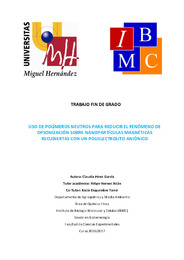Por favor, use este identificador para citar o enlazar este ítem:
https://hdl.handle.net/11000/4168Registro completo de metadatos
| Campo DC | Valor | Lengua/Idioma |
|---|---|---|
| dc.contributor.advisor | Hornos Adán, Felipe | - |
| dc.contributor.advisor | Esquembre Tomé, Rocío | - |
| dc.contributor.author | Pérez García, Claudia | - |
| dc.date.accessioned | 2017-10-24T11:40:13Z | - |
| dc.date.available | 2017-10-24T11:40:13Z | - |
| dc.date.created | 2017-07-12 | - |
| dc.date.issued | 2017-10-24 | - |
| dc.identifier.uri | http://hdl.handle.net/11000/4168 | - |
| dc.description.abstract | El uso de nanopartículas magnéticas ha ido creciendo de forma desmesurada durante las últimas décadas debido a la gran aplicabilidad que presentan. Podemos destacar su uso dentro del campo de la biomedicina, donde ya han sido usadas como agentes de contraste en imagen por resonancia magnética. Aunque aún en desarrollo, se pretenden utilizar como sistemas transportadores de biomoléculas, sin embargo, estas partículas al ser administradas podrían ser eliminadas del organismo por el sistema inmune (opsonización). En este trabajo se han obtenido nanopartículas de magnetita recubiertas con un polielectrolito aniónico y se ha caracterizado su capacidad máxima para adsorber Lisozima. Con el fin de reducir/evitar la opsonización, proponemos el tratamiento de las nanopartículas con distintos polímeros neutros, como polietilienglicol (PEG) de distinto peso molecular (400, 4000 y 35000 g/mol), polivinil alcohol (PVA) y polivinilpirrolidona (PVP). Los resultados parecerían indicar que de los polímeros utilizados, tanto el PEG 400 como el PVA aumentan la capacidad de adsorción de la nanopartícula (un 28 % y un 144 % respectivamente) favoreciendo la opsonización, el PEG 4000 no afectaría a tal fenómeno, y que solamente el PEG de 35000 y la PVP lo reducirían un 26 %. | es |
| dc.description.abstract | Use of magnetic nanoparticles has shown a significant increase during the last decades due to their numerous applications. In particular, in the biomedical field, where they have been used as magnetic resonance imaging contrast agents. Their application as drug delivery systems is now in development, but one of the main problems encountered is their elimination by the immune system (opsonization). In this work, we have obtained magnetic nanoparticles coated by an anionic polyelectrolyte and have characterized their adsorption capacity towards hen egg white lysozyme, used as a model cationic protein. As a working hypothesis, we have studied if several neutral polymers could compete with the protein for the charged surface of the nanoparticle as a means to decrease the adsorption to the nanoparticles of some of the proteins present in the biological media that initiates the opsonization process. In particular, we have studied the effect of polyethyleneglycol (PEG) of different molecular weights (400, 4000 y 35000 g/mol), polyvinyl alcohol (PVA) and polyvinylpirrolidone (PVP). The results suggest that PEG 400 and PVA increase the nanoparticle adsorption capacity (28% and 144%, respectively) promoting opsonization while PEG 4000 has a negligible effect and PEG 35000 and PVP reduce the protein adsorption capacity by a 26%. | es |
| dc.format | application/pdf | es |
| dc.format.extent | 37 | es |
| dc.language.iso | spa | es |
| dc.rights | info:eu-repo/semantics/openAccess | es |
| dc.subject | opsonización | es |
| dc.subject | NP-PAA | es |
| dc.subject | PEG | es |
| dc.subject.other | CDU::5 - Ciencias puras y naturales::57 - Biología | es |
| dc.subject.other | CDU::5 - Ciencias puras y naturales::54 - Química | es |
| dc.title | Uso de polímeros neutros para reducir el fenómeno de opsonización sobre nanopartículas magnéticas recubiertas con un polielectrolito aniónico | es |
| dc.type | info:eu-repo/semantics/bachelorThesis | es |

Ver/Abrir:
TFG Pérez García Claudia.pdf
1,63 MB
Adobe PDF
Compartir:
 La licencia se describe como: Atribución-NonComercial-NoDerivada 4.0 Internacional.
La licencia se describe como: Atribución-NonComercial-NoDerivada 4.0 Internacional.
.png)